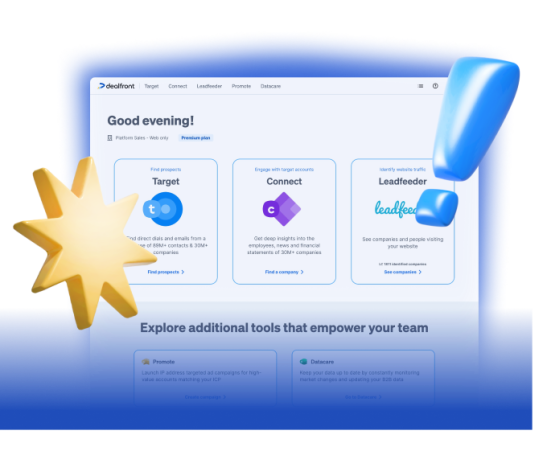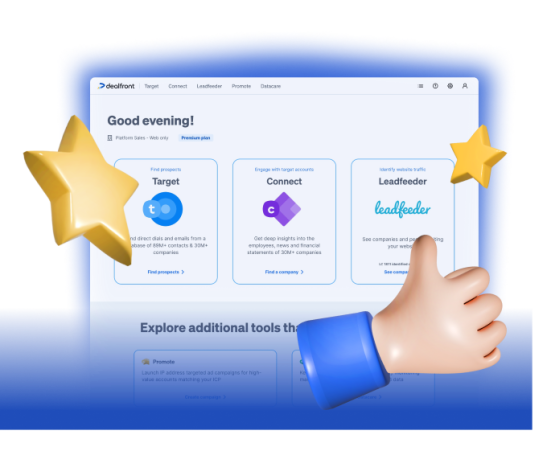More and more trusted brands keep popping up on social media. If you haven't tried (or heard about) social selling, you may not understand why this trend is happening. But by the time you're done reading this article, you'll gain a thorough understanding of social selling and how it could impact your business.
In a nutshell, social selling is a lead generation strategy for salespeople to build relationships with new prospects using social media. It capitalizes on the greater connectedness that social media platforms have given us, so social sellers can directly interact with prospects and customers instead of cold calling or sending out mass emails.
But how exactly can you leverage social media to really boost selling, and who exactly should be handling that? We fill you in on the true benefits and how it can fit into your overall sales strategy.
Who in your company handles social selling?
Social selling should be a company-wide effort. From your CEO to your newest salespeople, everyone should work on their personal brand and give effort to social selling. But the two main teams spearheading your social selling efforts should be marketing and sales.
Marketing teams
Marketing teams should create content that favorably represents your company and gives viewers or readers useful insights. They can then share this with the rest of the company, so everyone can post it on their social media platforms. That way, you can increase your brand's visibility while preserving your brand voice.
Sales teams
Your sales team should use the brand recognition that you get from social selling to close more deals. Reps also help outline your ideal customer profile (ICP), so marketing teams can tailor content to the people who are most likely to buy your products.
Each sales rep has multiple duties in a social selling strategy:
Building their personal brand
Sharing relevant content with their audience
Tracking key performance indicators (KPIs) to measure success
Following up with customers and prospects
Benefits of social selling
Social selling is a great way to increase your sales. Buyers feel more comfortable if they can look through your profile to know you're a credible business. Since you can communicate with buyers quickly and efficiently on social media, this strategy can also help close sales faster. But there are many other benefits that don't directly relate to sales, though they will increase your ROI in the long run.
An educated audience
Valuable content teaches your target audience more about your field of expertise. As they get smarter, they get better at solving daily problems that they run into. As they learn more, they can better understand where your product can fit into and simplify their workflow.
A solid personal brand
Social selling helps you establish yourself in your field and build your personal brand. As a result, your name starts coming up often in conversations within your industry. This increases your personal brand recognition, which helps your career flourish.
A loyal following
Social selling helps build relationships with your customers and prospects. With a bit of research on their profiles, you can learn a lot about your prospects before you've even talked to them. If they post about problems they've been dealing with, for example, you can plan to address them when you talk to them.
You can also show that you care about your customers by liking and sharing their posts or engaging with their social media content. These kinds of interactions let them know you appreciate their potential or continued business, which helps build a deeper, more genuine relationship and even raises your chance to close a sale. In fact, 72% of B2B buyers and 84% of B2B executives use social media as a source when they're deciding on a purchase.
What is social selling the inbound way?
Inbound social selling is a way to build a pipeline for leads using engaging and valuable content that people want to see to attract them to your account. Your sales team likely already looks at social media to learn more about your customer base, so they should have a good idea of what topics and types of content perform well with people in your ICP.
What is the social selling index?
The LinkedIn Social Selling Index (SSI) score is the platform's way of measuring how well you can connect and interact with your prospects. It rates your performance from 0 to 100, based on your success at:
Building a professional brand: Your profile should be complete with multimedia and a cover photo, along with endorsements and long-form posts that helped you gain followers.
Building strong relationships: A strong profile has a wide network of connections that includes people at the VP level and higher and internal connections, and it has a high acceptance rate for connection requests.
Finding the right people: You should be prospecting and researching well, which LinkedIn measures in terms of your advanced lead and account searches, inbound and prospecting profile views, saved leads, and days active.
Engaging with insights: LinkedIn values accounts that find and share valuable information. It considers factors like shares, messages you've sent and your response rate, groups you've joined, accounts you've saved, and the number of search views you get.
To be an industry leader, you should aim to get a score above 75. A score of 80 or more is generally a high Social Selling Index score.
The SSI is helpful to gauge how well you're building a profile and reaching out, but note that this tool isn't perfect. It measures your perceived influence within your network, so it could have a bias in favor of certain connections or inaccurately reflect your chance of converting connections. So, while you should track and improve your SSI score, you should also track more general KPIs to get a more accurate idea of your success.
Social selling pillars
Social networks are a large part of social selling strategies. Typically, marketing teams make materials for sales professionals to use while curating their own personal brands. In the realm of personal selling, establishing authentic connections and fostering relationships with potential customers is paramount for success. Here are the main aspects to focus on when building those relationships, along with KPIs to gauge your performance.

Personal branding
A strong personal brand makes prospects trust you more when you reach out. For B2B firms, it's important to come across as knowledgeable, professional, and up-to-date because your prospects will usually know a lot about your field.
To have a strong personal branding, you need to put together a profile with your customers in mind. Your profile should contain all important and relevant information and highlight specific times when you've provided value to customers in your work history.
An important KPI you should track is the number of endorsements your profile generates. A high number of endorsements is concrete proof of your expertise, which prospects would love to see.
Here are a few tips to improve your personal branding on your LinkedIn account:
Profile picture: You don't need a professional headshot, but it should accurately depict you as a businessperson.
Headline: Here, you can talk about your motivation to set yourself apart.
Summary: This should be a short elevator pitch for yourself as a contact.
Experience: It's best to make this section a concise summary of your experience with a few key bullet points, so viewers can quickly understand your work history.
Find the right prospects and customers
You should tailor your approach specifically to your ICP. If you cast a wide, overgeneralized net, you end up getting a poor conversion rate for the time and effort you've invested.
Draw up a list of key criteria for potential connections. For example, it could include:
Job description
Seniority
Industry or field
Or you could use Dealfront's Target tool to generate a list of companies that fit your ICP and people in the companies who fit your buyer persona. With this list, you can pinpoint the best people to connect and build relationships with.
You should track your clickthrough rate to rank your success in this step. You want to increase the number of connections that go from your content to your website or online store. Leadfeeder can help you get deeper insight by setting filters for leads and target companies to know when they visit your site and how they interact with it.
Engage with insights through content publication
Having many connections and followers is great, but you need to constantly engage them with interesting and valuable content to build trust. This also helps convince them that you're the right choice.
Make sure you share insightful and relevant content for your industry. While you should spread your company's marketing efforts, you should also reach wider. Sharing resources from other companies and commenting on content from industry experts will increase your visibility with your connections.
To track your progress in this step, you should follow your engagement. Do your posts often generate comments, shares, and more discussion? Your social selling strategy will improve as you find trends in pieces that perform well and ones that don't.
Develop trusted relationships by building an audience
The more you provide valuable information to your connections, the more you earn their trust. They will consider you as their go-to source of information and content in your niche, which makes them more eager to do business with you.
To encourage this, you should share and comment on posts that they've published. You should also regularly reach out with useful tips and information so they remember you as more than just someone selling a product.
3 steps to start a social selling strategy on LinkedIn at your company
Becoming a social selling company with a good Social Selling Index score isn't impossible, but if you try to do it blindly, you may feel overwhelmed or lost. Here are three simple steps to start your social selling strategy in the right direction.
Step 1: Create different versions of your brand content for employees to post twice weekly
Start by setting up multiple versions of brand content that you can send out to your employees. Giving them content to post ensures you maintain your brand voice and address the topics you want to cover. Employees are also more likely to engage in the strategy if they only need to pick a version they like and post it. You can then compare the performance of these versions to understand why some worked better than others.
A schedule of two posts per week is also a small commitment that's easy to maintain consistently. It also decreases your marketing team's workload while you figure out the type of content and topics that your audience engages with most. As you refine your strategy and see success, you can always adjust the content schedule accordingly.
Step 2: Create a small test group of employees to start with
Like any company-wide strategy, it helps to test it out with a smaller group first. Find people who would be interested in building the company's brand, making sure some of them are from your marketing and sales teams.
This group will likely be motivated to see the strategy succeed, so encourage them to give feedback and critique. They may be more active on the channels you want to target, so their input could help make the brand content feel more native to its respective platforms. But also make sure they understand your brand voice and values, so they can represent the company accurately.
This is also a good time to identify and discuss a few KPIs to track, such as comments or shares. If someone in your test group is more familiar with LinkedIn content, ask them what indicators they look for in posts they like to engage with.
Step 3: Evolve the strategy and work out the kinks!
Track the progress of your KPIs every week and check in with your test group regularly to discuss their observations. Take a look at the comments your brand posts get so that you can understand pain points about your brand and even your content.
You should also pay attention to LinkedIn posts that perform well according to your KPIs. Do they tend to be a certain content type? Are they typically topical or evergreen? What issues do they address? Think about how you can incorporate aspects of those posts into your brand content.
The good thing with social media is that consistency matters most. You'll start small and gain traction as you keep up your schedule. That also means it's great to experiment early on since your presence is small enough that everything is low-risk. And, by the time you pick up steam, you'll have a much better idea of what performs well.
Once you have identified the brand content that works well, communicate your strategy to all your employees. And remember that the social media landscape is always changing, so always track performance to make sure you can adjust accordingly.
Social selling best practices
There are many ways you could jump into social selling, but we’ve got some best practices that can help you do it better the first time.
Use relevant social platforms
Pick the social media platforms most appropriate for your target audience. For the B2B industry, this is LinkedIn. Once you've identified what it is, learn its tools and etiquette so you can get the most out of your presence on the platform.
By using the platform like a native user, you remove a wall of friction between you and your prospects or customers. This raises their engagement with your posts and helps build their relationship with your brand.
Connect with customers and prospects
Build your social networks organically with customers and prospects who you want to engage with. Personalize your connection request on LinkedIn instead of just using the default message.
In addition, avoid talking about sales right away once they accept your request. Instead, open with information that gives them value for free. People are generally more open to making a purchase once they feel like you've already given them some benefit.
Set up social listening alerts
Social listening tools are a great way to make sure you know when a prospect or customer has posted or updated their profile. Any update could be an opportunity to reach out and start a conversation with a lead. Here are a few examples of these opportunities, or trigger events, that social listening alerts can tell you about in an instant:
New profile views: If someone you'd like to speak with views your profile, you know they're interested in something you offer, so it's a great time to introduce yourself and begin a dialogue with them.
Career change or promotion updates: If a customer recently changed companies or received a promotion, sending them a personal congratulatory message helps build a relationship. And if you have a product or service that would help them in their new role, it's also a good time to let them know about it.
New posts on a prospect's page: Keeping up with the social media pages of your prospects and customers is a good way to find opportunities to leave a relevant comment that might solve their problem, which helps ensure that they remember you when they need a solution in the future.
New likes, comments, or shares on your content: If someone comments on or shares a recent post, it's a good time to open a conversation with them to deepen your relationship.
Be consistent
Set a schedule for implementing your social selling strategies and stick to it. Decide how often you’ll engage on social media with your marketing and sales teams. It may help to have each member of your sales team agree to focus solely on social media at different time slots during the week since there are a lot of different tasks like:
Sending messages
Posting relevant content
Looking for potential leads
Setting up appointments with prospects
Once your followers get used to your schedule, you may become part of their daily routine, which would increase engagement and help attract more sales leads.
Post interesting, relevant content
Try to post content that makes your brand look the most credible. It helps if it's relevant to your business offerings, like "how-to" or suggestion posts that teach your leads something about your industry or product.
Your posts don't need to be strictly original content—if you find good, relevant content from other sources, those are also good to post.
People also like to read about your company's successes because it makes them trust your brand more. So, for example, if your company wins an award, make a post about it or share a link that explains it. If there's a video (or photos) of someone in your company accepting the award, you can also include that in your content.

Look for referrals
When looking for potential leads, try to find people with mutual connections who could refer you. List out people you'd like an introduction with, then check if you have any mutual connections.
If you do, ask your current connection if they could introduce you through a referral. This is a more natural and successful introduction than a cold outreach since you can come to the lead from a trusted source.
But if there were just one piece of advice to give you it would be to show up consistently with the intention to give value to the people you seek to serve.
Social selling trends
Social media changes at a rapid pace, so approaches that you might have thought were creative or fresh a few years ago can be dull and ineffective now. But here are some emerging trends that we think will have more staying power.
Using direct messages
Direct messages give you one-to-one contact with prospects and customers. It helps to build rapport since you're sharing relevant information in a private setting. But, if you’ve never had a prior business connection with a potential customer there are a couple of things you have to keep in mind:
Keep the terms and conditions of the platform you’re both using in mind
Be sure to comply with any local regulations regarding cold outreach that may apply.
Posting video content
Video content is highly engaging because it requires less effort from viewers to learn the information you're sharing. Short, informative, well-edited videos are also very shareable, so your social selling strategy should include video content.
Paying attention to customer comments
It's easy to ignore customers' comments, but to build a strong social media presence, you need to take notice. Respond to comments, even if they're negative or critical. If you're sympathetic and respectful in your response, it could encourage the commenters to change their views or impressions about you.
Boost your sales with social selling
Even if you want to resist social media, all signs point to social selling being the new way to make sales. Social selling platforms enable you to build relationships with as many prospects and customers as possible, helping you sell more and secure repeat business. Because of the direct connection, you even have a shorter sales cycle.
As you figure out and keep improving your social selling strategy, let Dealfront help you out. Book a free demo to learn more about how our tools, like Target and Leadfeeder, help you find more high-quality B2B leads in a fraction of the time, so you can build relationships with the right people and boost your sales.





